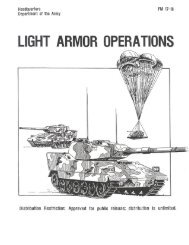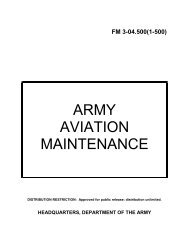fm 44-100 us army air and missile defense operations
fm 44-100 us army air and missile defense operations
fm 44-100 us army air and missile defense operations
You also want an ePaper? Increase the reach of your titles
YUMPU automatically turns print PDFs into web optimized ePapers that Google loves.
FM <strong>44</strong>-<strong>100</strong><br />
C-2<br />
C-6. One type orbit that is particularly <strong>us</strong>eful for wide area-continuo<strong>us</strong><br />
observation has a period of 24 hours <strong>and</strong> an inclination of 0 degrees. In this<br />
orbit, which is referred to as geosynchrono<strong>us</strong>, a satellite orbits the earth<br />
around the equator at the same rate that the earth rotates below the<br />
satellite. While the satellite orbits at very high speed at an altitude of 22,500<br />
miles, it appears to remain stationary over the same point on the earth's<br />
surface. Satellites in geosynchrono<strong>us</strong> orbit provide continuo<strong>us</strong> observation of<br />
most of a global hemisphere.<br />
SPACE SYSTEM LIMITATIONS<br />
C-7. While satellites can provide the Army many valuable capabilities,<br />
planners <strong>and</strong> <strong>us</strong>ers m<strong>us</strong>t underst<strong>and</strong> some of their general limitations.<br />
Though not all-incl<strong>us</strong>ive, the following limitations represent areas that m<strong>us</strong>t<br />
be considered when planning <strong>and</strong> requesting space support.<br />
Access<br />
Vulnerability<br />
Utility<br />
C-8. Satellites, <strong>and</strong> the launch <strong>operations</strong> which support them, are extremely<br />
expensive <strong>and</strong> manpower intensive. For these reasons, military satellites are<br />
national resources, supporting the NCA, CINCs, other services <strong>and</strong><br />
government agencies, <strong>and</strong> other tactical <strong>us</strong>ers. As a result, requirements can<br />
frequently exceed capacity <strong>and</strong> the system's capabilities. A validation process<br />
to determine what requirements will be satisfied is based upon priority <strong>and</strong><br />
system availability. The NCA, through the JCS, allocates satellite resources<br />
to the joint force comm<strong>and</strong>er who allocates those resources to <strong>us</strong>ers within<br />
the theater according to the JFC's priorities.<br />
C-9. Satellite systems are vulnerable to environmental conditions in space<br />
such as temperature extremes, radiation, meteoroids, <strong>and</strong> space debris.<br />
Atmospheric disturbances <strong>and</strong> solar activity such as solar flares also can<br />
affect satellite systems. Clouds, fog, <strong>and</strong> smoke affect the ability of imaging<br />
systems to see, <strong>and</strong> rain may degrade some radio signal frequencies. Solar<br />
flare <strong>and</strong> glare can blank out areas of the earth's surface from infrared<br />
observation for hours each day during the vernal <strong>and</strong> autumnal equinox<br />
period. Since blanked out areas differ for satellites in different orbits,<br />
redundant coverage of crisis areas by two or more satellites mitigates the<br />
effects of solar flare <strong>and</strong> glare <strong>and</strong> ensures continuo<strong>us</strong> coverage of the entire<br />
theater.<br />
C-10. Operationally, the Army is dependent upon systems currently on orbit,<br />
although these systems may or may not be suited to a particular Army<br />
mission. Satellites do not provide continual coverage; for example, LANDSAT<br />
sensors revisit a point on the earth approximately every 16 to 18 days.<br />
Moving a satellite to a more advantageo<strong>us</strong> orbit or position takes time <strong>and</strong> is<br />
limited to the amount of fuel on board since satellites cannot be refueled. As<br />
satellites age, components become degraded or fail, decreasing the satellite's<br />
utility <strong>and</strong> reliability. Satellites in geosynchrono<strong>us</strong> orbit have poor viewing<br />
geometry towards the edge of their coverage along the limb of the earth.











